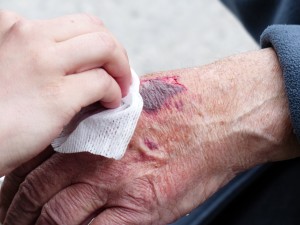Forensic Nursing
In the earlier days of this field of work, forensic nursing focused primarily on sexual assault and cases of abuse. However today the nurse may be involved with crime scene investigation, work with offenders in prison, counsel school children, and helping with death investigations.
Particularly in cases of sexual abuse, forensic evidence may not be immediately recognised by healthcare providers as crucial physical evidence, potentially resulting in it being lost. The presence of a forensic nurse can ensure the evidence is preserved and collected correctly. The nurse will document and collect evidence from the victim’s body, taking extensive notes and photographs in the process. Some nurses may be specifically trained sexual assault nurse examiners (SANE). Forensic nurses will generally become familiar with using rape kits or sexual assault evidence kits (SAEK). These are used to collect various forms of biological evidence from a victim of rape or sexual assault following such an incident, however the victim must give informed consent before such samples are collected. When processing the victim, the nurse will often first collect the victim’s clothing and package them individually in paper bags for further examination. The victim’s hair and pubic region is combed to collect any trace evidence. A sample of pubic hairs will also be collected from the victim as a control sample so as to confirm whether any hairs found on the victim belong to the offender or otherwise. Scrapings will be taken from under the victim’s fingernails to collect any possible trace evidence or skin cells belonging to the offender. Any obvious blood or seminal stains, potentially visualised using a UV light source, on the victim’s body will first be collected using a swab, either dry if the sample is still wet or dampened using distilled water if it is a dry sample. A number of vaginal and perhaps anal and oral swabs will be taken from the victim. The victim will be examined for any form of physical trauma, which will be documented and photographed using light sources if necessary. A colposcopy light can be attached to a camera and used to magnify, examine and photograph the vagina for any tears during an assault. Nurses may also use an omnichrome, which is a useful device that can detect bruising beneath the surface of the victim’s skin. This procedure of evidence collection is not limited to sexual assault victims, but also applies to any other case of assault or similar.
Not only will the nurse collect evidence in a hospital environment, but they may also be taken to crime scenes to collect evidence, blood and tissue samples. The nurse will also play a great role in the physical and emotional recovery of victims of trauma. Victims of domestic violence, sexual assault, and child or elder abuse or neglect may require psychological treatment following the incident. They may also play a role in the psychiatric evaluation of offenders and suspects, helping to determine whether or not they are fit for trial.
A role may also be played in non-criminal matters. For example the forensic nurse may liaise with the family of potential organ donors and ensure all legal paperwork is taken care of.

